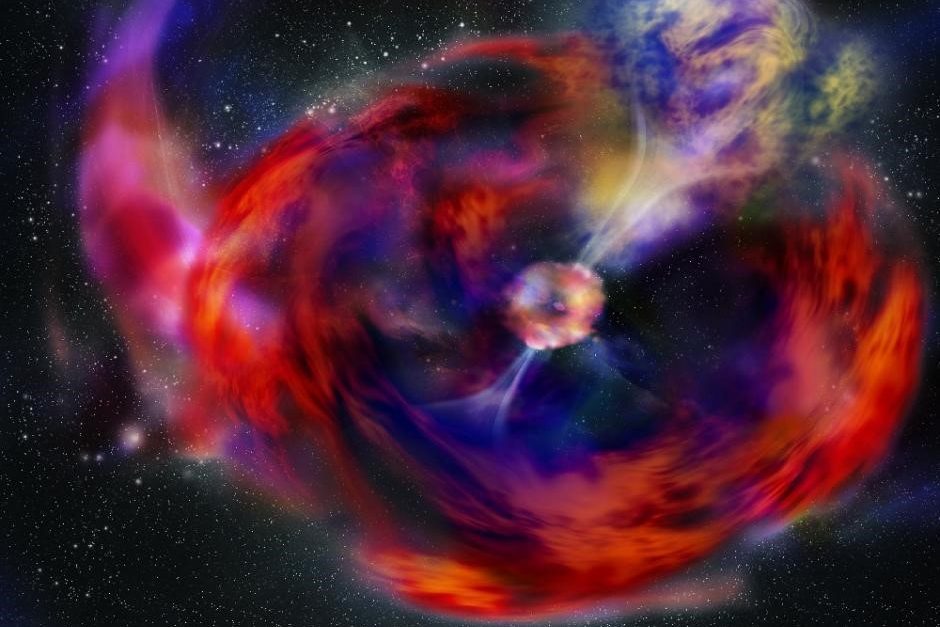New study in Nature Letters confirms theory about gamma ray bursts
Researchers from the DNRF’s Cosmic Dawn Center (DAWN) are part of a big international study in which researchers have analyzed observations of distant gamma ray bursts in the universe. The study connects the observations with the theory of what causes these gamma ray bursts, and the findings were recently published in the scientific journal Nature Letters.

An international research collaboration, including researchers from the DNRF Center of Excellence DAWN, the University of Copenhagen, and the Technical University of Denmark, is behind a large new study that helps confirm the theory of a link between black holes and gamma ray bursts with the help of data from gamma ray bursts (GRBs) observed in 2017.
Gamma ray bursts are short outbursts of gamma rays that can last from a couple of seconds or minutes to an hour. When a big star is dying, the core collapses into a so-called black hole. The black hole is surrounded by a disc that works as an enormous dynamo because the dying star is rotating at a high speed. The rotation creates a magnetic field from which two powerful jets are sent out of the black hole and into the universe. It is this light that is the gamma ray burst, and the material from within the star that is slipping out of the black hole is set free in the shape of a so-called jet cocoon.
Gamma ray bursts are such powerful light phenomena they cannot be caught by the naked eye, but only by satellites.
“GRBs represent the brightest phenomenon known to science – the luminous intensity of a single GRB may, in fact, exceed that of all stars combined! And at the same time, GRBs, which typically last just a couple of seconds, represent one of the best sources available when it comes to gleaning information about the initial stages of our universe,” explained Jonatan Selsing, post-doc at the DNRF’s Cosmic Dawn Center at the Niels Bohr Institute, Copenhagen. In addition to Selsing, Johan Fynbo, Daniele Malesani, and Kasper Heintz from DAWN are also part of the study.
Since 2004, The international Swift has been cicling in orbit around the Earth. The telescope’s job is to register gamma ray bursts, and Swift is able to constantly keep an eye on a third of the night sky. When Swift registers a gamma ray burst, the telescope immediately sends a text message to 100 different astronomers around the world, informing them about where in space the burst was observed.
At the beginning of December 2017, at 5 o’clock in the morning in Chile, a message was sent to Luca Izzo, an Italian astronomer and the main author on the study, who quickly notified the Very Large Telescope (VLT), the largest optical telescope in the world. Through analysis of the observations from the VLT, the researchers could see that the gamma ray burst was somewhat unusual.
“Not least because this is one of the closest GRBs ever observed. GRB171205A – which has since become the official name of this gamma ray burst – originated a mere 500 million years ago and has ever since traveled through space at the speed of light, that is, at 300,000 kilometers per second,” said Selsing.
With the help of measurements made with extremely sensitive equipment, called X-shooter, located on the VLT, the researchers could study the VLT footage of the gamma ray burst up close. Through image analysis of the observations, Selsing and the rest of the research team could determine that the jet cocoon in the gamma ray burst contained iron, cobalt, and nickel, elements that were created in the center of the dying star.
“One of the unique features of GRB171205A is that it proved possible to determine which elements this gamma ray burst released via the jet cocoon 500 million years ago. That was measured here at the Niels Bohr Institute, and that is our contribution to the Nature article,” said Selsing. He added:
“This corresponds with our theoretical expectations – and therefore also corroborates our model for a star collapse of this magnitude. Being able to establish that it actually did happen in this way is, however, really special. That’s when you get a glimpse of the very engine behind a gamma ray burst.”
According to Professor Jens Hjorth, who is head of center at the previous DNRF Center of Excellence DARK and a part of the study, the result supports the researchers’ theoretical idea concerning what happens in the transition from a heavy star to gamma ray bursts. In Hjorth’s words, this is a physical phenomenon that now can be supported by actual observations.
“Why is this interesting? Because it confirms a theory. We have different scenarios, but we are not sure that they are correct. The entire gamma ray burst area was once a great mystery, and then you get observations like these that provide us with a view on what is really going on,” explained Professor Hjorth to Videnskab.dk.
Read more about the research at the University of Copenhagen here
The scientific article can be found in Nature Letters here
More information about the research can be found at videnskab.dk here (in Danish)
